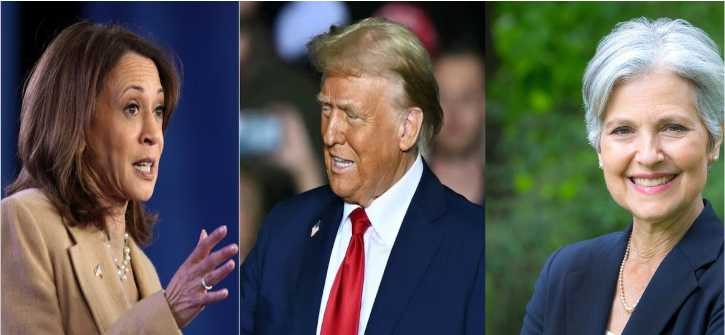High-Stakes U.S. 2024 Election: Harris, Trump, Jill and the Road Ahead
The 2024 U.S. presidential election is approaching a pivotal moment as Election Day draws closer. This race between Donald Trump, Jill Stein and Kamala Harris is being defined by heightened voter engagement, sharp polarization, and a range of critica


The 2024 U.S. presidential election is approaching a pivotal moment as Election Day draws closer. This race between Donald Trump, Jill Stein and Kamala Harris is being defined by heightened voter engagement, sharp polarization, and a range of critical issues that have the country divided. With record-breaking voter turnout expected, especially among women and older Americans, and close polls in battleground states like Pennsylvania, the outcome remains uncertain, adding to the tension and importance surrounding this election.
Record Voter Turnout Reflects High Stakes and Engagement
Voter turnout has reached unprecedented levels, with early voting data showing an overwhelming increase. Experts attribute this surge to the divisive issues at play, such as reproductive rights, economic stability, and healthcare access. Women, in particular, have emerged as a significant force, motivated largely by reproductive rights concerns. This demographic has been critical for Harris, especially in states like Pennsylvania, where her slight lead could hinge on strong turnout from women voters. Trump, on the other hand, has been focusing on his traditional base of older, conservative voters, aiming to counterbalance Harris’s appeal among younger and more progressive demographics.
Political experts suggest this heightened engagement could lead to one of the highest turnouts in U.S. election history. “This election is about more than just the candidates,” says political analyst Jenna Morales. “It’s about values and the direction of the country. Voters are showing up because they feel this decision will deeply impact their lives.”
The Green Party’s Jill Stein Joins the Race
Adding to the complexity of the 2024 election, Jill Stein of the Green Party has re-entered the race, advocating a progressive platform centered on environmental justice, economic reform, and social equity. Stein’s campaign highlights the urgency of climate change, promoting a “Green New Deal” aimed at transitioning to renewable energy and reducing carbon emissions. She also underscores healthcare as a human right and emphasizes the importance of social services.
Stein’s campaign has attracted support from younger, anti-war, environmentally-conscious voters and those seeking alternatives to the two-party system. Her message resonates particularly with voters concerned about climate action and income inequality. However, Stein faces the challenge of gaining substantial traction amid a polarized political landscape dominated by the two major candidates.
Core Issues: Abortion Rights, Economic Stability, and Healthcare
In this highly polarized environment, both candidates have crafted strategies focused on key voter concerns. For Harris, reproductive rights remain central. The issue has galvanized her base and helped her attract swing voters in key states, where women’s rights have emerged as one of the top election issues. Harris’s stance has resonated strongly with voters who support preserving access to abortion services, reinforcing her position as the choice for social progressives.
On the economic front, Trump has emphasized inflation and cost-of-living issues, framing his message around restoring economic stability by reducing inflation and boosting domestic industries. He argues that Harris’s policies would lead to excessive government spending and worsen inflation, a stance that Harris’s team strongly contests. Trump’s message is directed at Americans who have been hit hardest by rising costs and economic instability.
Healthcare reform is another cornerstone of Harris’s campaign, with a strong focus on expanding access and affordability. In response, Trump has advocated for deregulation and free-market solutions, emphasizing his commitment to reducing government intervention. Each candidate’s approach reflects the priorities of their core supporters while aiming to draw in undecided voters from swing states.
The Importance of Battleground States
With the nation evenly split, battleground states will play a decisive role in the election. Pennsylvania has become a primary focus, with both candidates investing significant resources and time there. Harris’s slight lead in Pennsylvania has energized Democrats, but Trump retains a strong base, particularly in rural areas, where his messages on inflation and economic revitalization resonate deeply.
Other critical states, including Michigan, Wisconsin, and Arizona, have also seen heightened campaign efforts. Harris’s approach has involved town halls and rallies to foster personal connections with voters, while Trump’s rallies have drawn substantial crowds of loyal supporters. Polls in these states show a closely contested race, with either candidate still able to secure victory.
“In such a closely contested race, even small shifts in voter sentiment in these states could have monumental impacts on the outcome,” commented political analyst Mark Goldberg.
Heightened Security Measures and Misinformation Countermeasures
With election tensions running high, security measures have been intensified across various states. Advanced protocols have been implemented to monitor potential threats at polling stations, and officials are focusing on countering the spread of misinformation, which has become a significant issue in this election cycle. Misleading narratives and fake news circulating on social media pose a risk of swaying voter decisions or dampening turnout, prompting state and local governments to prioritize information integrity.
To address the polarized atmosphere, election officials in some regions now operate under personal security protocols, reflecting the perceived threat levels surrounding this election. Nonpartisan groups are also playing a role by monitoring social media platforms, flagging content that could disrupt the electoral process.
The Potential for an “October Surprise”
With the race so close, the prospect of an “October surprise”—a last-minute revelation or event that could sway the election—looms large. Historically, unexpected developments in the final days of a campaign can impact voter sentiment, especially when polls are tight. Political analysts suggest that both campaigns remain on alert, preparing for any late-breaking news that could affect their chances.
Political historian Jeff Greenfield notes, “An October surprise has the potential to shift narratives at a critical moment. It draws in undecided voters and can even prompt others to reconsider their choices.”
This anticipation of a last-minute twist adds to the volatile nature of the election. While the outcome will likely hinge on core issues and voter turnout, the possibility of a disruptive event keeps both campaigns on edge.
Targeted Demographic Strategies and Grassroots Campaigns
Harris’s campaign has focused on mobilizing women, minorities, and younger voters—groups that traditionally lean Democratic and are particularly crucial in battleground states. Her outreach includes promises related to healthcare, climate change, and gender equality, and she has emphasized her role as a woman of color, hoping to resonate with minority communities and inspire a diverse voter base.
Trump’s strategy, meanwhile, has centered on rallying his core supporters, especially working-class voters drawn to his anti-establishment rhetoric. His rallies focus on job security, inflation, and immigration, and he has tailored his recent messages to include healthcare access and cost-of-living concerns, which resonate with suburban and rural voters alike.
Both campaigns have effectively leveraged social media, with Harris’s team utilizing Instagram and TikTok to connect with younger audiences and Trump maintaining a strong presence on platforms like Facebook and Twitter to engage his base.
Looking Ahead: The Future Direction of the U.S.
As Election Day approaches, the stakes of the 2024 presidential race continue to grow. With pressing issues like economic uncertainty, healthcare reform, and climate change on the line, the outcome will set the course for America’s future. For many, the choice between Harris and Trump represents a broader decision on the country’s values and priorities.
In battleground states, each vote counts, and polling experts predict record-breaking turnout. Voters are acutely aware of the implications of their choice, approaching the election with a sense of urgency and responsibility.
Final Push for Votes and the Road to Election Day
In the final stretch, both campaigns are making their closing arguments to the American public. Harris is expected to double down on healthcare and women’s rights, while Trump will continue to focus on economic and immigration issues. Both candidates are preparing for a last wave of events and advertisements to sway any undecided voters.
As tensions peak and the country watches closely, the 2024 election promises to be a pivotal moment in U.S. history. Whether Harris or Trump emerges victorious, the decision will shape policy directions in healthcare, the economy, and foreign relations. With stakes this high, the eyes of the world are on America as voters make their voices heard in one of the most consequential elections in recent history.

























![[Editorial] Ruling in the spotlight](https://europe.easybranches.com/images/2024/11/450x250/7012498.jpg)
![[Wang Son-taek] Some lessons from the 2024 US election](https://europe.easybranches.com/images/2024/11/450x250/7012497.jpg)
![[James Zarsadiaz] Asian American vote this year](https://europe.easybranches.com/images/2024/11/450x250/7012496.jpg)






